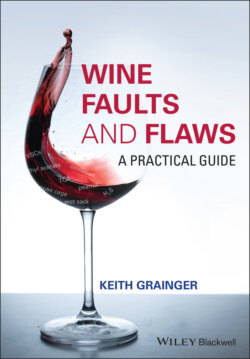Читать книгу Wine Faults and Flaws - Keith Grainger - Страница 41
2.1 Introduction
ОглавлениеThere are two ways a fault or flaw in a wine may be detected: by laboratory analysis, or by the organoleptic or sensory method, i.e. tasting. It may be argued that, as wine is made for tasting and drinking, a ‘technical’ fault, that is not apparent to a trained and experienced taster, is unimportant unless the fault were to develop and manifest itself on a subsequent occasion or lead to product deterioration. Sensory detection thresholds for important ‘fault’ compounds are discussed in the succeeding chapters in this book. It should be pointed out that published literature and research papers are far from being in consensus on the sensory detection threshold of individual compounds. Some of the disparities may be due to the nature of the panels of tasters: trained, untrained, experienced, inexperienced, age, gender, cultural background, etc. In fact, although one might expect that wine tasting ‘experts’ would be very sensitive to common aromas and flavours, it has been noted that they can show high olfactory detection thresholds for some key wine compounds, which is far from ideal when assurance of wine quality depends on fault detection at low levels [1]. Another challenge lies in the use and understanding of tasting lexicons, aroma, and taste descriptors. Whether described odour categories are innate or learned depends on the influence of language on odour processing. The question may be raised as to whether olfactory description systems are basic linguistic arrangements based on the taster's experience and exposure to expert lexicons [2].
Even if the primary purpose of a tasting assessment is to determine possible faults, a taster must be able to undertake a complete and thorough assessment of the wine, and the techniques and structure of doing this to ensure that all characteristics are examined, as detailed in this chapter. Some fault compounds, particularly haloanisoles, should result in rejection by a professional taster, at any level. However, there are other ‘fault’ compounds whose presence, particularly at a low level, may not lead to the rejection of a wine. It will depend upon the matrix of the wine and the relationship with all the sensory characteristics, including the wine's structure and balance. Some characteristics are sought after as part of the identity of certain wines but may be unacceptable in others. For example, the ‘struck flint’ and smoky notes of benzenemethanethiol, also known as benzene mercaptan, are almost a trademark of a classic Pouilly‐Fumé (Sauvignon Blanc) from the Central Vineyards of the Loire valley. Such aromas would be unacceptable in a Vouvray (Chenin Blanc) from Touraine, further down the river, so context is crucial. Of course, wine tasting encompasses a degree, sometimes a large degree, of subjectivity but following a rigorous tasting structure, together with subsequent comparing notes and opinions with colleagues, helps the taster reach an honest and balanced assessment, including whether some characteristics are indeed faults or flaws.
Some of the information in this chapter is based upon content from Wine Production and Quality 2nd edn. by Keith Grainger and Hazel Tattersall [3]. This material has been revised and expanded. Many additional topics related to wine tasting are discussed in further detail in that work.
Every wine drinker is, to a greater or lesser extent, a wine taster. However, most wine consumers taste and drink the product without much thought other than whether or not it is enjoyable and meets their expectations. The wine lover gives the wine a more detailed appraisal and considers balance, complexity, and typicality (in the wine world very often referred to as tipicité). Neither is looking to find a fault, although if present, it may scream out and prohibit all enjoyment of the wine. The trade student, oenologist, winemaking consultant, or quality control manager have a much more detailed agenda in their tasting assessments and will follow a consistent and rigorous structure. The detection of any fault or flaw is an essential part of such tasting analysis.
The selection of tasters, for making professional judgements will encompass many criteria, including expertise in the types of wines to be assessed. There is an International Organisation for Standardization (ISO) standard for such selection: ISO 8586/2012: General guidelines for the selection, training, and monitoring of selected assessors and expert sensory assessors [4]. This standard is under review at the time of writing and is due to be replaced by ISO/CD 8586. ISO 8586/2012 defines expert sensory assessors as ‘selected assessors with a demonstrated sensory sensitivity and with considerable training and experience in sensory testing, who can make consistent and repeatable sensory assessments…..’ Key to an individual's suitability is being able to perform with precise accuracy and, crucially, reproducibility. Of course, a long‐term sensory memory is essential to make reliable comparative judgements.
